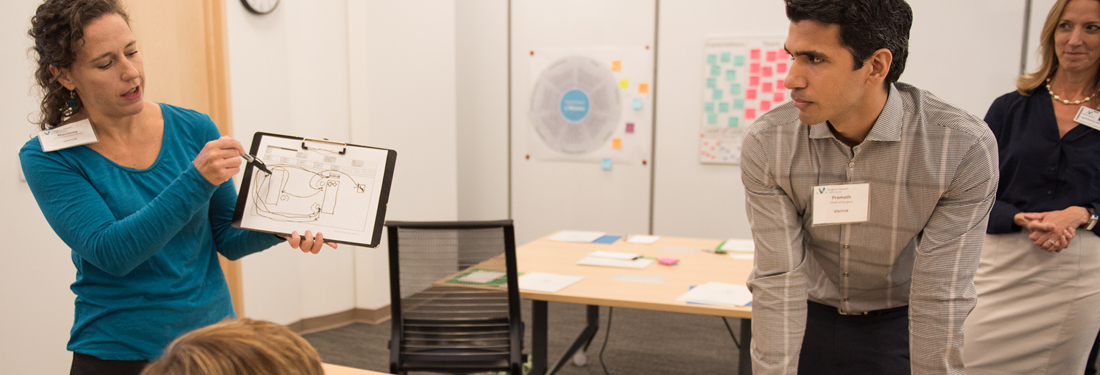Innovation: directed creativity implemented
“At Virginia Mason, our definition of innovation is directed creativity implemented”
– Amy Tufano
Over the course of a transformation journey, drivers of change evolve. It is common for improvement initiatives to begin with a consultant, then see that work shift to the organization’s improvement department, for example. A defining moment then comes when the impetus for change shifts to the frontline team members who actually do the work — and when each worker has the knowledge of improvement tools and the skills to drive innovation every day.
Reaching this stage takes time and a great deal of work. It involves nothing less than a fundamental cultural change — a shift from top-down improvement to one where change is driven continuously at the frontlines. Having the skills and tools is only part of the equation. The organizational culture must be one in which all employees feel empowered and encouraged to initiate and lead change.
Getting to this point is a significant breakthrough for any organization, but even at that juncture there are challenges: Innovation can be overwhelming — it is an exciting concept. But how do you keep innovation simple and understandable? What do you do to continue to ensure all team members have the ability to make innovation central to their job functions?
Obstacles to innovation are everywhere. “We have mental valleys in our thinking, ruts we are stuck in,” says Amy Tufano, a faculty member at Virginia Mason Institute. “While mental valleys are useful for daily communication, it can get in the way when we need to think differently and see new possibilities. The challenge is how do we escape our current thinking — escape from that valley and see the landscape and horizon? At Virginia Mason, our definition of innovation is ‘directed creativity implemented.’ By direct creativity, we mean having a clear purpose behind the idea generation. Then you implement. Creativity is fun and exciting, and we like to think we are creative, but at the end of the day, if we have 100 idea forms on wall, where does that get us? If you don’t take action it does not benefit patients or staff.”
Attention, Escape, Movement
One approach to drive positive change is the attention, escape, movement technique, which can be summarized this way:
- Attention involves deep focus on the problem by defining the current state and the defects therein.
- Escape involves getting out of the current situation and searching outside health care for solutions.
- Movement is taking action that benefits people — both patients and team members.
Everyday Lean Ideas
Another tool that helps ensure team members can drive innovation is Everyday Lean Ideas (ELI). This vibrant initiative enables Virginia Mason team members to identify “rocks in their shoes” and find solutions. ELIs have proven highly valuable among Virginia Mason’s Patient Financial Services (PFS) team members.
“It is a very powerful tool,” says Kara Cuzzetto, a manager in revenue operations. “It’s not just that I tell my leader an idea and it goes into a black hole where nothing happens. We think of it as a way to remove rocks from your shoes. What is going on around you that drives you crazy, slows you down? And how can we fix those things?”
Generating and implementing ELIs is essential to the success within PFS. In fact, PFS has led all Virginia Mason departments in the number of ELIs generated for four consecutive years.
ELIs are small items that may seem mundane individually, but their collective impact is significant. For instance, PFS sends hundreds of faxes each week, most of which go to a fairly small number of payers — both private insurers and government programs, such as Medicare. Previously, team members would punch in the fax numbers and hit send. But a PFS team member suggested loading the numbers into the fax memory. By doing so, they can now hit a single digit that automatically establishes a fax connection to the desired payer.
Yes, this ELI is small. But multiply it by a hundred or a thousand, and the continuous efficiency improvements become clearer.
“The majority of our improvements are staff-driven improvements through ELIs and huddles to the production board and many of our processes,” says Cuzzetto. “It is very important that all of these high concepts — creativity, innovation, lean — distill down to simple things, such as attention, escape and movement, as well as daily management.
Daily Management
Another way Virginia Mason teams sustain an innovative culture is through standard work for leaders. Standard work for leaders is derived from daily management (a subset of World Class Management).
Daily management helps define standard work for leaders throughout the organization. It is designed to identify and fix problems in real time, and it has proved to be a powerful accelerator within the Virginia Mason Production System.
The PFS team uses daily management “throughout our day,” says Cuzzetto. “One of the most useful ways is in the form of a daily huddle where we gather every morning at 7:45 to plan our day. The huddle lasts just 15 minutes, but covers a great deal of territory. Most importantly, it enables the team members to start their day fully in sync.”
The huddles allow teams to identify trends much more quickly than they would be able to do without huddles.
Cuzzetto puts it this way: “Because we are in a heads-down production environment, we might have five folks assigned to one payer group, and they may not individually identify something as a trend. But in huddles, we have those conversations and we can clearly see trends when reported by several different team members.”
When Lisa Ness became a supervisor four years ago, the practice was “to batch issues about payers and discuss them once a month,” she says. “Today, because we talk about these issues in our daily huddle, we resolve them much more quickly.”
The value of the morning huddle is so ingrained in the daily work of the PFS team that “even when we are out, the team still huddles without us,” says Michael Williamson, a PFS supervisor. “It’s their work, it’s their huddle. When the leaders aren’t there, informal leaders on those teams lead huddles.”
During the huddles, for example, workers who have performed particularly well of late are recognized. Recently identified barriers are described, any new issues with a payer are discussed, and a new ELI might be identified.
Multiple approaches enable Virginia Mason to ensure all team members have the ability to drive positive change every day; to keep innovation simple and understandable; to ensure all team members have the ability and are empowered to make innovation central to their job functions.
Another key aspect of daily management is the production board. The team has engaged in many kaizen events through the years. One of the more impactful came as early as 2006 (just four years into Virginia Mason’s lean journey) when a Rapid Process Improvement Workshop resulted in a shift from a handwritten production board to a sophisticated Excel document to which all team members have real-time access.
In daily management, the production board is a valuable, visual display of metrics essential to the department’s ability to perform at the highest level. The production board is a critical element of daily management within PFS, says Ness. “We deal with a constant flow of information and the board allows us to make it as transparent as possible so everyone on the team knows where we stand at all times.”
With the production board, team members can see, for example, that there are a number of accounts outstanding, with balances ranging from a few hundred to a few thousand dollars. The board will also show that there is an account where $100,000 is due. With that kind of clarity, team members know in real time which accounts to spend their time working on.
How does your organization ensure team members are empowered to drive meaningful change?
Originally published September 10, 2014, updated March 14, 2022





